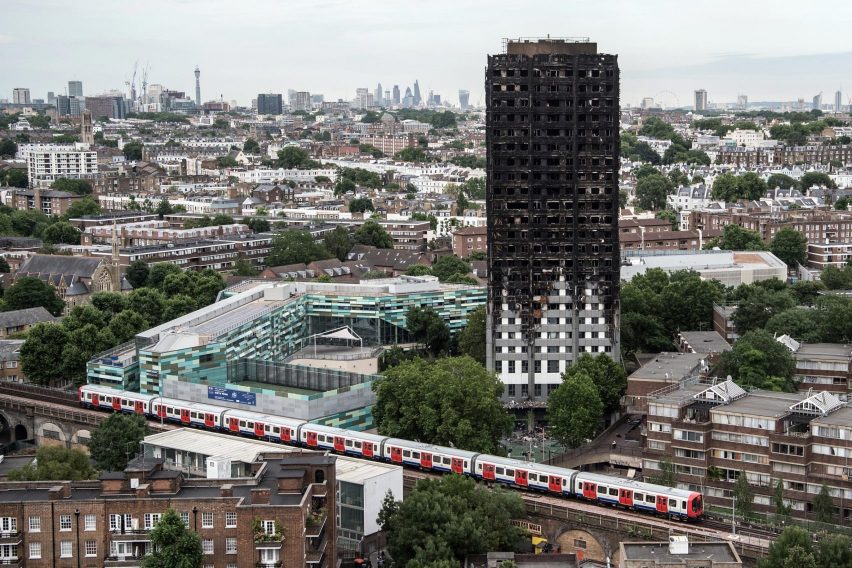
UK government announces cladding ban following Grenfell Tower fire
The UK government is set to announce a ban on all combustible cladding, including the type used to refurbish Grenfell Tower before the fatal fire in 2017, on buildings over 18 metres high.
Speaking at the Conservative Party conference today, housing secretary James Brokenshire will say that the shock of the "unimaginable horror" of the Grenfell Tower fire has "underlined the need to do all that we can to see that such a disaster cannot happen again."
The ban will cover all combustable material being used to clad new residential buildings, schools, hospitals, care homes, and student accommodation in England and Wales.
The only materials approved for external walls will be A1 and A2 class materials such as metal, stone, glass, or plasterboard.
MP for Kensington, the borough of Grenfell tower, Emma Dent Coad told Dezeen the ban was a "very welcome first step" and commended Grenfell United and all the campaign groups for lobbying the secretary of state for increased regulations.
"It is vital that all levels of combustibility are banned on all buildings, so we look forward to reading the detail on this, and seeing the improved building regulations we need to ensure all homes are safe," she added.
Ban won't cover cladding on existing buildings
It is now 15 months since the Grenfell Tower disaster, when 72 people died as a result of a fire that spread rapidly up and across cladding added to the sides of the 67-metre-high tower, in the early hours of 14 June 2017.
Current regulations allow cladding with fillers and insulation of "limited combustibility".
The ban, due to be implemented in building regulation changes before the end of autumn, will not be applied retroactively to high-rise buildings that have already been clad in this type of material.
A £400 million project to remove this kind of cladding from high-rise social housing blocks in England is currently underway. The Guardian reported that 470 high rise blocks with Grenfell-style cladding have been identified.
Private blocks with this kind of cladding have been advised to remove and replace it by previous housing secretary Sajid Javid, who asked developers and building owners not to pass the costs on to residents.
Some owners have refused to pay, leaving residents fearful of insurmountable bills. In May developers Barratt Homes had to step in and offer to cover the £2 million costs of replacing cladding on a block in Croydon that failed fire safety tests when the private company that owns the block left leaseholders with the bill.
Cladding allowed fire to spread
In April this year a leaked report prepared by fire experts BRE Global for the Metropolitan Police's investigation said that combustable cladding and insulation, along with poorly installed window frames and a lack of fire barriers, added "fuel" to the fire.
Aluminium composite rainscreen cladding was added to the exterior of the 1970s tower as part of renovation works undertaken on behalf of the local council by architects Studio E and renovation firm Rydon between 2015 and 2016.
When a faulty fridge caught fire in a flat on the fourth floor on 14 June 2017 fire fighters initially thought they had extinguished the blaze. Instead, it spread rapidly up one side of the building, before moving to the other three sides.
In under four hours the entire building was engulfed by flames.
Fire fighters blame building for disaster
The first phase of a public inquiry into the Grenfell Tower fire is currently underway. Fire fighters who attended the scene are currently finishing giving their evidence, and many have blamed the building for the deaths that night.
Speaking at the inquest, deputy assistant commissioner Andrew O'Loughlin said the spread of the fire was so shocking "no-one should have lived in the building". In his closing comments, fire commander Richard Welch said "the building let us all down".
Standard procedure for high rise tower fires is to advise residents to stay put in their homes unless they are being directly affected by the fire, as tall buildings should be designed to contain fires and prevent their spread.
At Grenfell the stay-put policy was considered to have failed by 1.29am, just half an hour after the first fire crew arrived at the scene, but was not abandoned until 2.47am.
Evidence from the bereaved, survivors and residents will be heard from 3 October. The second phase, which is due to begin early next year, will examine the tower's original design and construction, and the later refurbishment work.